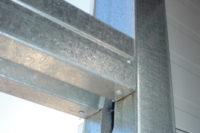
The building industry is changing-for the better. There has been an undeniable shift toward more sustainable construction. Recent research predicts that sustainable building will grow at a rate five times that of conventional building. Today, more than ever, designers, builders and contractors are challenged with creating energy efficient, quiet, productive environments in a cost effective, sustainable manner. If buildings are going to be competitive in the future, they will need to provide superior energy efficiency, occupant comfort and sustainable design in a cost effective manner for owners and occupants alike.
Insulation contributes directly to all of these important attributes by providing improved indoor air quality, acoustical performance and thermal protection while allowing for greater architectural design freedom. But the benefits don’t end there. The largest benefit is likely the enormous impact that insulation can have on a building’s ability to be more sustainable. In fact, few materials have a greater impact on a building’s ability to be “green.” And, when you consider that insulation actually saves owners money in the long run, it becomes evident that insulation might possibly be the most important thing a building owner can do to ensure both long-term cost savings and environmental sustainability.

ENERGY USE IN THE MARKETS
According to the Energy Information Administration, residential and commercial buildings are responsible for about 40 percent of the energy use and 39 percent of the greenhouse gas emissions in the United States. Energy efficiency through insulation is the simplest, most cost-effective way to reduce energy use and the associated greenhouse gas emissions.Insulation is inherently carbon negative. The amount of energy it saves is overwhelmingly greater than the energy it takes to make the product. From an energy savings standpoint it is perpetual, as once in place, it uses no energy to save energy.
According to Energy Conservation Management Inc., glasswool (fiber glass) insulation saves 12 times as much energy per pound in its first year in place as the energy used to produce it. And it continues to save that much more energy each year it is in place. All insulation products installed in U.S. buildings currently save consumers 12 quadrillion Btu annually, reducing the amount of energy they would have used by about 42 percent compared to having no insulation.

From a carbon reduction standpoint, the impact of insulation is similarly amazing. Insulation currently in place in U.S. buildings reduces our CO² emissions by about 780 million tons each year, which is equivalent to over 150 coal-fired power plants.
The energy savings that owners experience from optimizing insulation levels are as impressive as the carbon reduction. The United States uses a lot of energy-nearly a million dollars worth each minute, 24 hours a day, every day of the year. Sadly, 56 percent of all energy in the U.S. economy is wasted-including 20 percent of all the energy used in residential and commercial buildings. Recovering just a small part of that lost energy is a significant dollar savings for the building owner, increases the square foot value of the building and provides additional cash flow on a sustainable basis.

RETURN ON INVESTMENTS
Insulation is a known technology that has an immediate economic impact and provides a substantial environmental payback. Glasswool insulation products have always been sustainable because of what they are made from: sand, one of the world’s most abundant, renewable resources and recycled glass. Now, however, new technologies have been introduced that elevate their sustainability even further.An example of one such more sustainable technology is a recent innovation called Ecose technology brought to market by Knauf Insulation. The company introduced this new bio-based binding technology to replace the petro-based chemicals that were traditionally used in fiber glass insulation. It reduces the binder embodied energy by up to 70 percent as compared to Knauf’s previous products, and does not contain phenol, formaldehyde, acrylics or artificial colors. Additionally, the technology reduces the expected Global Warming Potential and total embodied energy by approximately 4 percent.
In addition to the environmental benefits that can be reaped by optimal insulation of walls and ceilings, building owners are experiencing additional savings because of federal tax benefits. These incentives provide financing and incentives for state and local governments to reduce greenhouse emissions, and for builders and developers to build efficient buildings or to improve existing buildings. Commercial building owners and lessees, who purchase and install energy-saving products, including insulation, qualify for a tax deduction. A deduction of up to $1.80 per square foot is available for buildings that save at least 50 percent of the heating and cooling energy of a building that meets ASHRAE Standards. Partial deductions of up to 60 cents are available for additional insulation measures that can be taken in the building envelope.
Insulating walls and ceilings pays huge green dividends. By making a building more sustainable and energy efficient, the building’s value is increased-operating and utility costs are lower, resale value is higher and market attractiveness increases. In the future, all building will be assessed over its lifecycle, and no product contributes more to sustainable construction than insulation. W&C


Report Abusive Comment